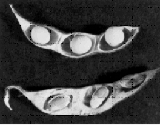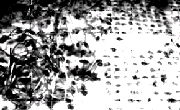Reports on Plant Diseases |
RPD No. 506 - Soybean Seed Quality and Fungicide Seed Treatment
|
March 1988
|
[ Seed Quality ] [ Storing
and Handling Soybean Seed ] [ Tests for Seed Quality
] [ Fungicide Seed Treatment ] [
Chemicals Used for Seed Treatment ] [ Seed Treatment
and Nodulation ] [ Summary ]
|
Planting high quality seed is important to an efficient soybean production
system. Early planting, reduced seeding rates, and drill planting all
require high quality, vigorous seed to obtain optimum stands and yields.
Strong seedlings grow faster than less vigorous ones, are more tolerant
to adverse conditions in the seedbed, and are better able to resist diseases.
Diseases affecting seed quality and yield differ in severity among cultivars,
years, and locations, but the pathogens responsible are well established
in most production areas. Soybean seed produced in warm, wet seasons or
where rain has delayed the harvest is often of poor quality. Using fungicide
seed treatments provides cheap insurance against seedborne and soilborne
seed rots and against seedling blights (Figure 1). Although fungicide
seed treatments generally increase the stand, such treatments do not always
insure higher yields.
|

Figure 1.
Seedling blight: (Left) healthy seedling; (Right) seedlings attacked
by seedborne or soilborne fungi.
|
Seed Quality
Many factors affect seed quality. Seedborne fungi, insect damage, adverse weather
(such as frost), improper storage, and physiological aging all reduce seed vigor
and viability. Any rough or excessive handling of dry or moist seeds at harvest
or planting can cause cracked seedcoats and kill seed embryos. These cracks
may be microscopic, but they still can increase seed rot by allowing nutrients
to escape and by providing an entry for soil-inhabiting and/or seed-rotting
fungi.
Pod and stem blight and seed decay, both caused by fungi of the Diaporthe/Phomopsis
complex, are the major problems of soybean seed grown in Illinois and elsewhere
in the Midwest (Figure 2). Decayed seeds are elongated, shriveled, discolored,
and often covered with white mold growth (Figure 3). Healthy appearing, symptomless
seeds also may be infected and can develop into blighted or infected seedlings.
Seed decay is most severe when the crop has matured under high rainfall and
humidity and when harvest has been delayed by wet weather. Seedlots with 20
to 40 percent of the seeds decayed by Phomopsis spp. are not uncommon in years
when weather has favored an epidemic.
Back to Top

Figure
2. Pod and stem blight: (Top) healthy pod and seed; (Bottom)
pod and seed infected with the pod- and stem-blight fungus.
|
Seed transmission of other fungi that cause such diseases
as purple seed stain, stem canker, anthracnose, and downy mildew also
is common. In general, the incidence of these seedborne diseases also
increases during prolonged wet periods from bloom to harvest and when
the harvest is delayed. Insect damage to pods and seeds may reduce
seed quality directly and can contribute to seed decay by providing
wounds for the entry of other, weaker pathogens, such as those causing
yeast spot and Alternaria seed decay.
In summary, poor field emergence is a result of physiological,
pathological, and environmental stresses–often acting in combination
|
Back to Top
Storing and Handling Soybean Seed

Figure
3. Poor quality seed showing cracking, discoloration, and
mold growth. Some 70 percent of this seedlot germinated in a warm
test. Such soybean seed should not be planted.
|
The storage and handling of soybean seed is very important.
Moisture levels above 13 percent encourage the growth of fungi that
can reduce viability. Extremely dry seed ( 9 to 10 percent moisture)
can be cracked and damaged easily. Seed should be handled as little
as possible and kept cool and dry. Seed that is easily broken or cracked
(a moisture content of less than 9 or 10 percent) should not be treated
other than in the planter box. The extra handling can cause excessive
mechanical damage. The condition of soybean seed can be determined
roughly by putting samples in a container of cool, clear water for
about 2 minutes, then sorting out the sounds, hard seeds from the
soft, puffy ones. Soft, puffy seeds would indicate cracked seed coats
and the possibility of poor germination caused by mechanical damage;
such seed should be properly tested before planting. |
Tests for Seed Quality
The Illinois Crop Improvement Association (3105 Research Drive, Champaign,
IL 61821) will perform several inexpensive tests to determine seed quality.
All certified seed grown in Illinois is tested for warm germination, vigor
(strong seedlings), and percent diseased seed, primarily Phomopsis. Other
tests, such as percent cold germination, are available on request.
Ratings of seed quality are useful in determining planting rates and
the situations in which seed treatment may be advantageous. Planting high
quality, certified seed is strongly recommended whenever possible. Such
seed usually do not need a fungicide treatment, but the necessity of treatment
depends not only on the seed quality but also on the field conditions
at planting time. The following guidelines can be used to determine relative
seed health and whether a fungicide seed treatment would be beneficial.
1. Healthy, vigorous seed. Seed treatment would be of little or no value
unless: (1) adverse conditions, such as cool soil, in the seedbed at planting
time make a delay in germination likely, (2) a reduced seeding rate is used,
or (3) the field is used for seed production.
2. Seed that is below average to poor in quality. A fungicide seed treatment
should increase the stand and perhaps the yield. However, it is always
best to obtain high quality seed if possible.
3. Seed lots with a rating lower than those above should not be planted
if at all possible.
Back to Top
Fungicide Seed Treatment
|
Proper seed treatment with a fungicide will increase the germination
of poor quality seed if the low quality is the result of fungal
infection (Figure 4). A fungicide treatment also protects the seeds
and young seedlings from many seedborne and soilborne pathogens.
Seeds infected with fungi, or planted where there is likely to be
a delay in emergence, benefit the most from a fungicide treatment.
Poor germination caused by mechanical damage, physiological aging,
or other nonpathological factors will not be affected by fungicide
seed treatments.
Table 1 shows the results of two trials at the University of Illinois
at Urbana-Champaign. In field No. 1, the stand and yield were increased
by seed treatment because diseases had significantly reduced the
untreated stand. Although the stand with treated seeds was increased
in field No. 2, the stand from sowing untreated seeds was adequate
to produce a high yield. Studies in various Midwestern states have
shown that stands from treated seeds may vary considerably without
consistently influencing yields. Increased yields from seed treatment
occur only where the stands from untreated seeds are poor–numerous
skips of more than 6 inches, or 14 centimeters. Each planting situation
is different, requiring the consideration of seed quality, planting
rate, seedbed conditions, and the likelihood of rapid emergence.
|

Figure
4 . Warm germination test performed by the Illinois Crop Improvement
Association showing seedlings from (Left) good quality seed and
(Right) low germination from poor quality seed.
|
Back to Top
Chemicals Used for Seed Treatment
Seed treatment products are available in several formulations–wettable
powders, flowables, dusts, or liquids. These products can be custom-applied
in slurry, ready-mix, or mist-type treaters or can be mixed directly as
a dust in the planter or drill box. Many people are sensitive to certain
seed-treatment chemicals and should not handle them. Numerous seed dealers
and elevators offer custom service on fungicide seed treatments. Treated
seed should be stored safely and should never be used for food, feed,
or oil purposes.
A number of different fungicides and fungicide combinations (sold under
a wide variety of trade names) have been registered with the federal Environmental
Protection Agency for use on soybeans. The fungicides suggested for treating
soybean seed are given in the Illinois Agronomy Handbook 2001, available
in your nearest Extension office or at University of Illinois Ag Services
P345, 1917 S. Wright St., Champaign, IL 61820.
Seed Treatment and Nodulation
Fungicide seed treatments have no serious effect on nodulation where
nodulated soybeans have been grown previously. The inoculation of soybean
seed with Rhizobium is not necessary in Illinois if a well-nodulated crop
has been grown within the past 5 years. If inoculation does become necessary,
a fungicidal seed treatment can still be used. Most available chemicals
show little or no adverse effect on the Rhizobium bacterium if exposure
before planting time is minimized, that is, if the seed is planted within
2 hours after being treated with a fungicide. If Rhizobium and a fungicide
are applied simultaneously in the planter box, do the mixing just before
planting.
Summary
A fungicide seed treatment is recommended when:
1. Seed is grown for seed production. Research has shown that
seed of higher quality with a lower percentage of fungal infection are
produced when the seed is treated with a fungicide before planting.
2. Planting at a reduced seeding rate.
3. Germination is delayed because of unfavorable soil or weather conditions,
such as early planting in cool or cold soil (below about 55 F or 13 C)
or planting in dry soil.
4. Poor quality seed must be used and fungal infection is the reason
for poor germination.
Back to Top |
For further information concerning
diseases of crucifers and other vegetables, contact Mohammad Babadoost, Extension
Specialist in Fruit and Vegetable Diseases, Department of Crop Sciences, University
of Illinois at Urbana-Champaign. University
of Illinois Extension provides equal opportunities in programs and employment.
|



